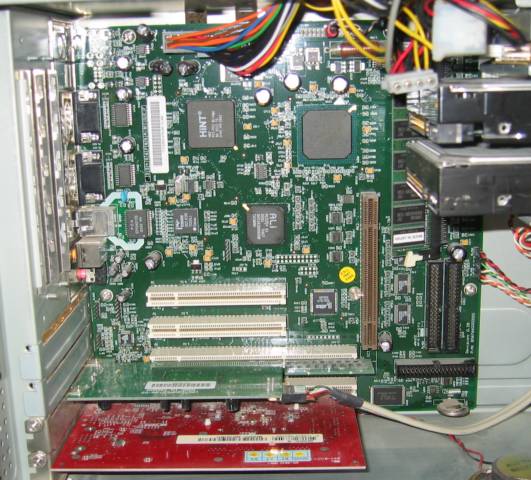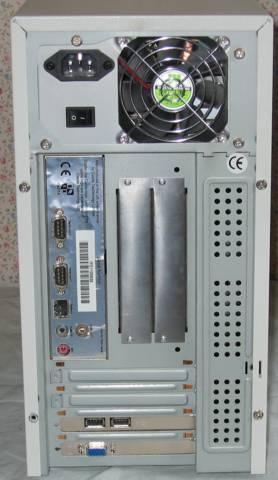Iyonix on:
[Wikipedia]
[Google]
[Amazon]
The Iyonix PC was an
 The Iyonix originated as a secret project by
The Iyonix originated as a secret project by

 * Standard
* Standard Iyonix Linux port established , Drobe.co.uk archives
/ref> * Support for "legacy" Acorn DEBI expansion cards *
Iyonix website
Iyonix review
by The Icon Bar
Iyonix review
Announcement of end of production
{{RISC OS RISC OS ARM-based home computers
Acorn
The acorn, or oaknut, is the nut of the oaks and their close relatives (genera ''Quercus'' and '' Lithocarpus'', in the family Fagaceae). It usually contains one seed (occasionally
two seeds), enclosed in a tough, leathery shell, and borne ...
-clone personal computer
A personal computer (PC) is a multi-purpose microcomputer whose size, capabilities, and price make it feasible for individual use. Personal computers are intended to be operated directly by an end user, rather than by a computer expert or tec ...
sold by Castle Technology
Castle Technology Limited, named after Framlingham Castle, was a British computer company based in Cambridge, England. It began as a producer of ARM computers and manufactured the Acorn-branded range of desktop computers that run RISC OS.
Fo ...
and Iyonix Ltd between 2002 and 2008. According to news site '' Slashdot'', it was the first personal computer to use Intel's XScale processor. It ran .
History
 The Iyonix originated as a secret project by
The Iyonix originated as a secret project by Pace
Pace or paces may refer to:
Business
*Pace (transit), a bus operator in the suburbs of Chicago, US
* Pace Airlines, an American charter airline
*Pace Foods, a maker of a popular brand of salsa sold in North America, owned by Campbell Soup Compan ...
engineers in connection with development of set-top box
A set-top box (STB), also colloquially known as a cable box and historically television decoder, is an information appliance device that generally contains a TV-tuner input and displays output to a television set and an external source of sign ...
es (STBs), and has been noted as a successor to the . Pace had a licence to develop RISCOS Ltd's OS sources for use in the STB market. The Iyonix was developed under the code name ''Tungsten'' and uses , which is a version of RISC OS that supports ARM CPUs with 32-bit addressing modes. The sources and hardware design were subsequently acquired by Castle, who developed them into the final product.
Castle continued to keep the project a secret, requiring developers to sign a non-disclosure agreement
A non-disclosure agreement (NDA) is a legal contract or part of a contract between at least two parties that outlines confidential material, knowledge, or information that the parties wish to share with one another for certain purposes, but wish ...
. Information was distributed to such developers via a confidential section of the website. Customers were occasionally able to buy the computer as a bare bones system for self-assembly.
After speculation on the usenet newsgroup
A Usenet newsgroup is a repository usually within the Usenet system, for messages posted from users in different locations using the Internet. They are discussion groups and are not devoted to publishing news. Newsgroups are technically distinct ...
s, a website for the hardware was spotted in mid October 2002. Units first went on sale in December 2002. Prices started from £1249.
Castle ceased production of the Iyonix after the July 2006 introduction in the UK of the RoHS
The Restriction of Hazardous Substances Directive 2002/95/EC (RoHS 1), short for Directive on the restriction of the use of certain hazardous substances in electrical and electronic equipment, was adopted in February 2003 by the European Unio ...
Regulations. The design was not compliant and Castle did not redesign the Iyonix. Sales continued for another two years via a newly established company, Iyonix Ltd, which enabled Castle itself to circumvent the regulations.
On 25 September 2008, Castle announced that production of the Iyonix had ceased and that new units would no longer be available to order.
Features
Features include:
 * Standard
* Standard ATX
ATX (Advanced Technology eXtended) is a motherboard and power supply configuration specification developed by Intel in 1995 to improve on previous de facto standards like the AT design. It was the first major change in desktop computer enclo ...
motherboard and Nvidia
Nvidia CorporationOfficially written as NVIDIA and stylized in its logo as VIDIA with the lowercase "n" the same height as the uppercase "VIDIA"; formerly stylized as VIDIA with a large italicized lowercase "n" on products from the mid 1990s to ...
video card
A graphics card (also called a video card, display card, graphics adapter, VGA card/VGA, video adapter, display adapter, or mistakenly GPU) is an expansion card which generates a feed of output images to a display device, such as a computer moni ...
* Intel XScale 80321 600 MHz
The hertz (symbol: Hz) is the unit of frequency in the International System of Units (SI), equivalent to one event (or cycle) per second. The hertz is an SI derived unit whose expression in terms of SI base units is s−1, meaning that one he ...
32-bit
In computer architecture, 32-bit computing refers to computer systems with a processor, memory, and other major system components that operate on data in 32-bit units. Compared to smaller bit widths, 32-bit computers can perform large calculation ...
processor
Processor may refer to:
Computing Hardware
* Processor (computing)
**Central processing unit (CPU), the hardware within a computer that executes a program
*** Microprocessor, a central processing unit contained on a single integrated circuit (I ...
* Two 64-bit
In computer architecture, 64-bit Integer (computer science), integers, memory addresses, or other Data (computing), data units are those that are 64 bits wide. Also, 64-bit central processing unit, CPUs and arithmetic logic unit, ALUs are those ...
and two 32-bit PCI
PCI may refer to:
Business and economics
* Payment card industry, businesses associated with debit, credit, and other payment cards
** Payment Card Industry Data Security Standard, a set of security requirements for credit card processors
* Pro ...
slots (two occupied by graphics and USB cards, two free)
* RISC OS version 5 in hardware ROM
Rom, or ROM may refer to:
Biomechanics and medicine
* Risk of mortality, a medical classification to estimate the likelihood of death for a patient
* Rupture of membranes, a term used during pregnancy to describe a rupture of the amniotic sac
* R ...
module, using 32-bit addressing mode.
* Support for the Linux
Linux ( or ) is a family of open-source Unix-like operating systems based on the Linux kernel, an operating system kernel first released on September 17, 1991, by Linus Torvalds. Linux is typically packaged as a Linux distribution, which ...
operating system/ref> * Support for "legacy" Acorn DEBI expansion cards *
USB
Universal Serial Bus (USB) is an industry standard that establishes specifications for cables, connectors and protocols for connection, communication and power supply (interfacing) between computers, peripherals and other computers. A broad v ...
interfacing
It was the first time substantial changes had been made to the platform since the release of the Risc PC
The Risc PC is Acorn Computers's RISC OS/ Acorn RISC Machine computer, launched on 15 April 1994, which superseded the Acorn Archimedes. The Acorn PC card and software allows PC compatible software to be run.
Like the Archimedes, the Risc PC co ...
in 1994. All interim machines had been built on the ARM7500 system on a chip
A system on a chip or system-on-chip (SoC ; pl. ''SoCs'' ) is an integrated circuit that integrates most or all components of a computer or other electronic system. These components almost always include a central processing unit (CPU), memory ...
, which was widely regarded as a single-chip Risc PC. (It incorporated the memory controller, video, sound, IO and CPU logic of a Risc PC, leaving only memory and disc interfacing to be added.)
The presence of PCI and USB capabilities, as well as the retained "podule" bus, attracted comparisons to Acorn's aborted Phoebe PC; however, such comparisons should be tempered with Phoebe's proposed feature set, which retained VIDC and 26-bit mode, and although Phoebe was intended to be capable of SMP configurations, its proposed shipping configuration had been for one SA110 CPU.
References
External links
Iyonix website
Iyonix review
by The Icon Bar
Iyonix review
Announcement of end of production
{{RISC OS RISC OS ARM-based home computers